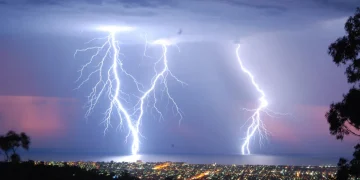Storm Eowyn Wind Warnings: UK’s Essential Safety Guide

Storm Eowyn wind warnings have become increasingly important for UK residents as severe weather events grow more frequent and intense across the British Isles. This comprehensive guide examines the meteorological significance of these warnings, their impact on daily life, and the essential preparations needed to ensure safety when Storm Eowyn wind warnings are issued. Understanding these critical alerts can make the difference between proper preparation and potential danger during extreme weather events.
Understanding the UK’s Wind Warning System
The Met Office operates a colour-coded warning system that classifies Storm Eowyn wind warnings based on their potential impact and likelihood. Yellow warnings indicate possible disruption to daily activities, whilst amber warnings suggest a heightened risk of structural damage and transport disruption. Red warnings, the most severe classification, signal potentially life-threatening conditions requiring immediate protective action.
Storm Eowyn wind warnings are typically issued 24-48 hours before anticipated severe weather events, providing crucial lead time for preparations. These warnings include specific information about expected wind speeds, directional patterns, and the duration of severe conditions. The Met Office meteorologists analyse complex atmospheric data to determine when and where these warnings should be implemented.
Each warning contains specific geographical boundaries, allowing residents to understand precisely which regions will be affected by Storm Eowyn’s powerful gusts. The warning system has evolved significantly in recent years, becoming more localised and specific to improve public safety responses.
The Science Behind Storm Eowyn Wind Patterns
Storm Eowyn wind warnings result from complex atmospheric conditions that create powerful weather systems. These storms typically develop in the North Atlantic region when significant temperature differentials between air masses generate intense low-pressure systems. As these systems move across the UK, they produce the severe winds that necessitate Storm Eowyn wind warnings.
The Coriolis effect, resulting from Earth’s rotation, influences Storm Eowyn’s wind direction and intensity. In the Northern Hemisphere, this creates the characteristic anticlockwise rotation around low-pressure centres that meteorologists track when issuing wind warnings. The topography of the British Isles further influences wind patterns, with mountainous regions often experiencing stronger gusts due to funnelling effects.
Climate scientists have observed that changes in global atmospheric circulation patterns are potentially increasing the frequency and intensity of storms requiring wind warnings. Recent research suggests that warming ocean temperatures may contribute to more powerful winter storms affecting the UK, making Storm Eowyn wind warnings even more critical for public safety.
Wind Speed Classifications and Their Impacts
Storm Eowyn wind warnings include specific information about expected wind speeds, which directly correlate to potential damage levels. Understanding these classifications helps residents prepare appropriately:
- Light Breeze (6-11 mph): No warning typically issued; minimal impact
- Moderate Winds (12-24 mph): Possible yellow warnings in vulnerable areas; may affect high-sided vehicles
- Strong Winds (25-38 mph): Yellow warning likely; can cause minor structural damage
- Gale Force (39-54 mph): Amber Storm Eowyn wind warnings often issued; significant travel disruption likely
- Severe Gale (55-63 mph): Strong amber warnings; structural damage probable
- Storm Force (64-72 mph): Red Storm Eowyn wind warnings possible; dangerous conditions
- Violent Storm (73-103 mph): Red warnings; severe and widespread damage expected
- Hurricane Force (104+ mph): Red warnings; catastrophic damage possible
The Met Office carefully calibrates Storm Eowyn wind warnings to these speed thresholds, considering additional factors such as ground saturation, seasonal foliage levels, and infrastructure vulnerabilities in each region.
Historic Storm Eowyn Events and Their Lessons
The UK has experienced several significant weather events that prompted severe Storm Eowyn wind warnings in recent years. Examining these historical cases provides valuable insights into the effectiveness of the warning system and the importance of public compliance.
In January 2022, Storm Malik brought winds exceeding 80 mph to parts of northern England and Scotland, resulting in widespread power outages affecting over 80,000 homes. The Met Office had issued amber Storm Eowyn wind warnings three days prior, allowing emergency services to position resources strategically and potentially reducing casualties.
February 2020 saw Storm Ciara sweep across the UK with gusts reaching 97 mph in parts of Wales and northern England. The comprehensive Storm Eowyn wind warnings issued beforehand contributed to reduced road traffic during peak storm hours, likely preventing numerous accidents despite the severe conditions.
These historical events demonstrate that when residents heed Storm Eowyn wind warnings promptly, the risk to life and property diminishes significantly. Each major storm provides meteorologists with additional data to refine future warning systems, continuously improving the accuracy and utility of these critical alerts.
Practical Preparations When Storm Eowyn Wind Warnings Are Issued
When Storm Eowyn wind warnings are announced, residents should undertake specific preparations to protect themselves and their property. These practical steps can significantly reduce risk during severe weather events:
For your home:
- Secure loose objects in gardens and balconies, including furniture, bins, and plant pots
- Close and securely fasten doors and windows
- Park vehicles in garages where possible, or away from trees and buildings
- Check roof tiles and repair any loose sections before the storm arrives
- Consider boarding up windows if red Storm Eowyn wind warnings are issued
For personal safety:
- Create an emergency kit containing torches, batteries, first aid supplies, and bottled water
- Charge mobile phones and other essential devices before the storm
- Identify the safest room in your home, typically one with minimal windows
- Plan alternative accommodation if you live in a particularly vulnerable area
- Stay informed by keeping a battery-powered radio available
For travel considerations:
- Avoid unnecessary journeys during the height of storms with active Storm Eowyn wind warnings
- If travel is essential, allow extra time and check transport services before departing
- Be particularly cautious on bridges and exposed roadways
- Be aware that rail services may operate with reduced speeds or be cancelled entirely
- Consider how you would manage if stranded away from home
Insurance experts recommend documenting your property’s condition before storms hit, which can facilitate claims if damage occurs despite preparations. Taking photographs of your home’s exterior and any valuable garden items provides important evidence for insurance purposes.
Vulnerable Populations and Storm Eowyn Wind Warnings
Certain demographic groups face heightened risks during severe weather events and require special consideration when Storm Eowyn wind warnings are issued. Local authorities typically maintain registers of vulnerable residents who may need additional assistance during extreme weather.
Elderly individuals living alone may struggle with physical preparations and face greater danger if power outages affect heating systems during cold weather. Community support networks should activate when Storm Eowyn wind warnings are issued, with neighbours checking on vulnerable residents.
People with medical conditions requiring electricity-dependent equipment need particular attention during severe storms. These individuals should register with utility providers for priority restoration services and maintain backup power options when possible.
Rural communities often experience more prolonged service disruptions when Storm Eowyn wind warnings materialise into severe weather events. These residents should maintain more substantial emergency supplies and consider alternative communication methods if standard telecommunications fail.
Technology and Storm Eowyn Wind Warning Communications
Modern technology has revolutionised how Storm Eowyn wind warnings reach the public. The Met Office app provides real-time alerts directly to smartphones, allowing for immediate notification when warnings are issued or updated. This technology includes precise GPS-based alerts that target only those in affected areas.
Social media platforms play an increasingly important role in disseminating Storm Eowyn wind warnings. Official meteorological accounts provide regular updates, while community groups often share localised information about specific impacts. However, users should verify information through official channels to avoid misinformation during severe weather events.
Emergency services and local authorities use integrated communication systems to coordinate responses when Storm Eowyn wind warnings indicate potential widespread impacts. These systems allow for rapid deployment of resources to affected areas and provide consistent public messaging about safety measures.
Frequently Asked Questions About Storm Eowyn Wind Warnings
Q: How accurate are Storm Eowyn wind warnings? A: The Met Office reports that their wind warnings have approximately 80% accuracy for predicting severe conditions 24 hours in advance. This accuracy improves to over 90% for warnings issued within 12 hours of storm events.
Q: What’s the difference between Storm Eowyn wind warnings and general weather forecasts? A: Storm Eowyn wind warnings are specific alerts issued only when severe conditions may impact safety or infrastructure. Standard forecasts provide general weather conditions but don’t necessarily indicate dangerous situations requiring protective action.
Q: How should I prepare pets and livestock for severe wind events? A: Bring smaller pets indoors during severe Storm Eowyn wind warnings. For livestock, ensure access to sturdy shelter, move animals from areas with potentially dangerous debris, and store extra feed if access may be restricted during or after the storm.
Q: Do insurance policies cover damage from events with Storm Eowyn wind warnings? A: Most standard home insurance policies cover wind damage, but coverage details vary between providers. Review your policy before storm season and consider documenting your property’s condition before storms for potential claims.
Q: How can I report dangerous conditions during severe wind events? A: Contact local emergency services for immediate dangers. For infrastructure damage like fallen power lines, contact relevant utility companies. Many local authorities also maintain storm reporting systems to help coordinate responses.
Understanding and properly responding to Storm Eowyn wind warnings represents an essential life skill for UK residents. As climate patterns continue to evolve, the likelihood of experiencing severe wind events increases across the British Isles. By familiarising yourself with warning systems, preparing adequately, and staying informed through official channels, you can significantly reduce risks during these challenging weather events.
What experiences have you had with severe storms and wind warnings? Have you found particular preparation strategies especially effective? Share your insights in the comments section below to help others in our community prepare for future severe weather events.





